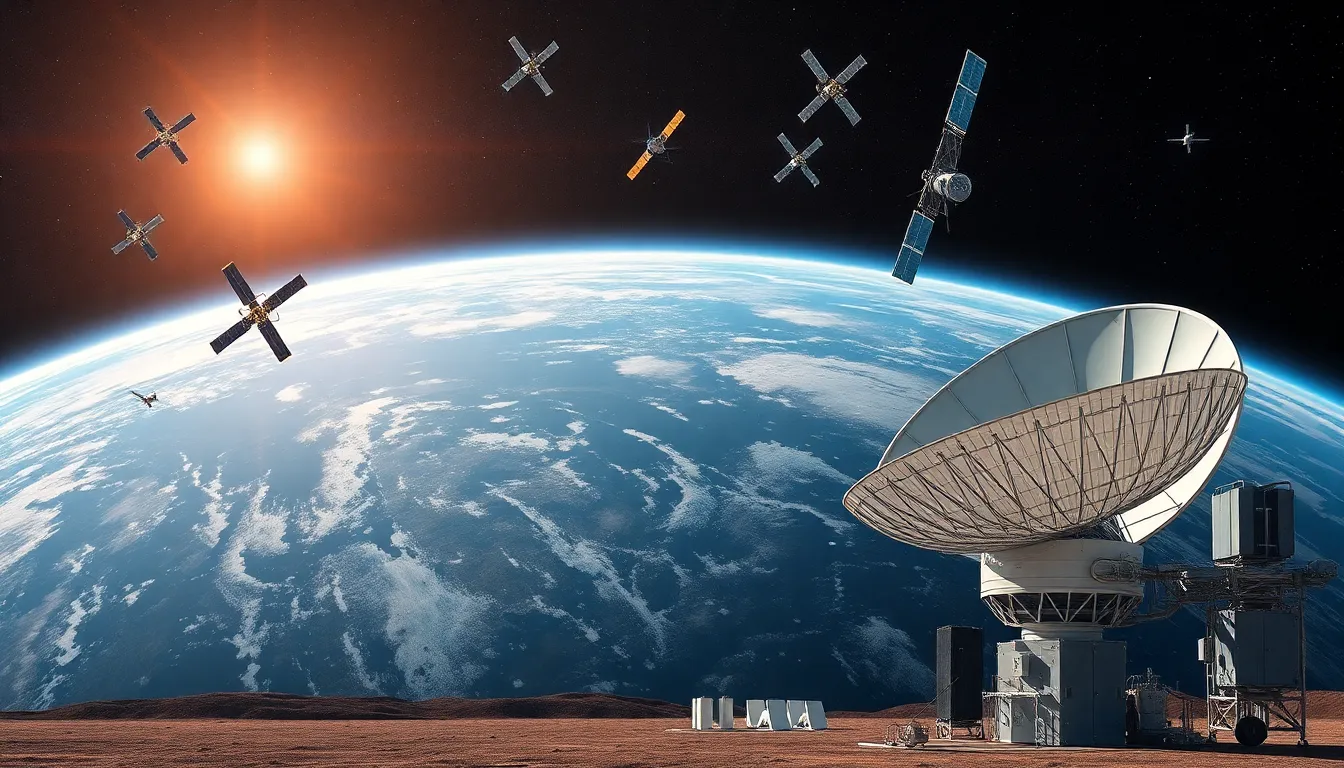Table of Contents
ToggleIn a world where data drives decisions, satellite monitoring systems have become essential tools for various industries. These advanced technologies enable real-time observation of Earth’s surface, providing invaluable insights into everything from climate change to urban development. As the demand for accurate information grows, organizations are turning to satellites for a clearer perspective on global and local phenomena.
Satellite monitoring systems leverage cutting-edge technology to gather data from space, transforming it into actionable intelligence. They play a pivotal role in environmental management, disaster response, and resource allocation. With the ability to track changes over time, these systems offer a unique lens through which to understand our planet’s dynamic nature. As the capabilities of satellite technology continue to expand, so does its impact on society and the environment.
Overview of Satellite Monitoring Systems
Satellite monitoring systems utilize a network of satellites to gather data about the Earth’s environment and surface. These systems operate by capturing images and measurements from various sectors, including agriculture, forestry, urban planning, and disaster management. They convert this information into actionable insights, essential for decision-making processes across industries.
Key components of satellite monitoring systems include:
- Satellites: Equipped with sensors, satellites collect data in various wavelengths, such as visible light, infrared, and radar. They can provide continuous, real-time observations.
- Data Processing: Advanced algorithms analyze satellite data to generate accurate models and forecasts. Techniques such as machine learning enhance data interpretation for specific applications.
- User Interfaces: Software platforms display processed information, allowing users to visualize and analyze data effectively. These interfaces offer tools for mapping, reporting, and monitoring trends.
Applications of satellite monitoring systems span multiple fields:
- Environmental Monitoring: Systems track deforestation, desertification, and pollution, enabling effective environmental management.
- Agricultural Assessment: Farmers use satellite data to monitor crop health, optimize irrigation, and maximize yields.
- Urban Planning: City planners leverage satellite imagery for land use assessments, infrastructure development, and disaster preparedness.
- Disaster Response: Rapid satellite data helps agencies coordinate efforts during natural disasters, providing vital information for crisis management.
As technology advances, satellite monitoring systems become increasingly integrated into everyday operations, driving efficiency and promoting sustainable practices for businesses and governments alike.
Key Components of Satellite Monitoring Systems

Satellite monitoring systems consist of several critical components that work together to provide comprehensive data on Earth’s conditions. These elements include satellites equipped with advanced technology and ground stations that facilitate data transmission and analysis.
Satellites
Satellites serve as the primary data-gathering tools in monitoring systems. Equipped with various sensors, satellites capture images and measurements related to atmospheric conditions, land use, and environmental changes. Types of satellites include:
- Earth Observation Satellites: Focus on capturing high-resolution images for environmental monitoring and resource management.
- Weather Satellites: Provide real-time data on weather patterns, aiding in climate studies and disaster preparedness.
- Communication Satellites: Facilitate data transmission between satellites and ground stations, ensuring timely access to information.
Ground Stations
Ground stations play a vital role in satellite monitoring systems. They operate as hubs for receiving and processing satellite data. Key functions of ground stations include:
- Data Reception: Receive signals from satellites and convert them into usable formats.
- Data Processing: Analyze incoming data using advanced algorithms, ensuring accuracy and reliability.
- User Interface: Provide visualization tools to interpret satellite data effectively. These interfaces enable stakeholders to make informed decisions based on the analyzed information.
These components work in unison to enhance the effectiveness of satellite monitoring systems across various applications, significantly impacting environmental management and resource allocation.
Applications of Satellite Monitoring Systems
Satellite monitoring systems play a crucial role across various sectors, facilitating the collection and analysis of data that support operational efficiency and informed decision-making. Key applications include environmental monitoring, agriculture and land use, and disaster management.
Environmental Monitoring
Environmental monitoring utilizes satellite systems to track changes in ecosystems and assess factors such as air quality, water resources, and deforestation. Satellites equipped with multispectral sensors capture data to evaluate different environmental indicators, including temperature, rainfall, and vegetation cover. Organizations like NASA and the European Space Agency deploy Earth observation satellites to generate reliable data for climate research, biodiversity assessments, and natural resource management. These data contribute to an understanding of climate patterns and help policymakers formulate strategies for sustainability.
Agriculture and Land Use
Agriculture and land use applications leverage satellite imagery to enhance crop management and monitor land development. Precision agriculture methods benefit from real-time data on soil moisture, nutrient levels, and pest activity, enabling farmers to optimize yield. Satellite systems monitor land use changes, helping urban planners identify growth patterns and assess environmental impacts. For instance, the European Space Agency’s Copernicus program provides farmers with monitoring tools that facilitate precision farming practices, ensuring sustainable land use while maximizing productivity.
Disaster Management
Disaster management relies on satellite monitoring systems to improve preparedness and response strategies during natural disasters. Satellite imagery provides critical information for assessing damage during events such as hurricanes, earthquakes, and floods. Rapid data acquisition allows emergency responders to evaluate affected areas and allocate resources effectively. Organizations like FEMA and the UN utilize satellite data for mapping disaster zones and planning recovery efforts, ensuring timely assistance to communities. The integration of satellite monitoring enhances resilience against disasters, ultimately saving lives and reducing economic losses.
Advantages of Satellite Monitoring Systems
Satellite monitoring systems provide numerous advantages across various sectors. These benefits stem from advanced technology, extensive data coverage, and real-time capabilities.
- Global Coverage: Satellite monitoring systems offer extensive data collection over vast geographic areas. Their ability to observe remote regions ensures no area remains unmonitored, benefiting industries like agriculture and environmental management.
- Real-Time Data Acquisition: Satellite technology enables instant data gathering and analysis. This real-time capability aids in timely decision-making, essential during natural disasters or emergencies.
- High-Resolution Imagery: Many satellites capture high-resolution images, providing detailed insights into land use, environmental changes, and urban development. This clarity supports better planning and resource management.
- Cost-Effective Monitoring: Using satellite systems reduces the need for extensive ground-based infrastructure. Organizations can monitor large areas with fewer resources, significantly cutting operational costs.
- Environmental Insights: Satellite systems help track climate change indicators, such as temperature, sea level rise, and deforestation. These insights support research and policy-making aimed at mitigating environmental issues.
- Improved Agricultural Practices: Satellite imagery provides real-time data regarding crop health and soil conditions. This information enhances precision farming, optimizes resource allocation, and increases yields.
- Enhanced Disaster Response: Satellite monitoring systems play a crucial role in disaster preparedness and response. They provide critical data during natural disasters, facilitating efficient resource deployment and improving recovery efforts.
- Data Integration Capabilities: These systems can integrate with other technology platforms, enhancing data collection and analysis. This capability allows stakeholders to utilize combined data sets for more comprehensive assessments.
- Versatile Applications: Satellite monitoring systems apply to various fields, including defense, logistics, and infrastructure development. This versatility showcases their essential role across multiple industries.
- Support for Sustainable Practices: By providing comprehensive environmental data, satellite systems promote sustainability initiatives. They empower organizations to implement eco-friendly practices and monitor their effectiveness.
These advantages illustrate the transformative potential of satellite monitoring systems in providing actionable intelligence and fostering informed decision-making across varied domains.
Challenges and Limitations
Despite the advancements in satellite monitoring systems, several challenges and limitations exist. These obstacles can affect the effectiveness and reliability of the data provided.
- Data Resolution: Data resolution varies across satellite systems. Lower-resolution images might obscure critical details necessary for precise analysis, leading to inaccuracies in applications like urban planning or environmental monitoring.
- Atmospheric Interference: Atmospheric conditions, such as cloud cover and smoke, hinder the clarity of satellite imagery. These factors can distort data collection and reduce the reliability of observations, especially in regions prone to frequent weather disturbances.
- Signal Disruption: Satellite signals can face disruption from obstacles like tall buildings or mountains. In urban areas or remote locations, this disruption can affect data transmission, limiting the effectiveness of real-time monitoring.
- Data Processing Challenges: The vast amounts of data generated require sophisticated processing capabilities. Slow processing speeds can delay decision-making, impacting operations in time-sensitive situations, such as disaster response.
- Cost of Implementation: Setting up satellite monitoring systems involves significant costs. Organizations may find it challenging to balance the expense of satellite technology with the benefits gained, especially for smaller enterprises or developing nations.
- Regulatory and Privacy Issues: Regulatory frameworks surrounding satellite data use and privacy concerns complicate operational processes. Intrusive data collection can raise ethical questions, impacting public trust and leading to potential legal hurdles.
- Limited Temporal Resolution: Some satellites revisit specific areas infrequently. Limited temporal resolution can result in gaps in critical environmental data, which may hinder timely intervention or assessment of changes.
- Dependence on Technology: Overreliance on satellite systems can lead to decreased field observations. Ground-based verification is essential for corroborating data but may be neglected, resulting in incomplete insights.
- Technical Limitations: Technical limitations of sensors, such as sensitivity and dynamic range, restrict the ability to capture certain types of data. These limitations can hinder the full potential of satellite monitoring systems in various applications.
By addressing these challenges, stakeholders can enhance the efficacy of satellite monitoring systems and improve the quality of data they provide across different sectors.
Future Trends in Satellite Monitoring Systems
Satellite monitoring systems are evolving, driven by technological advancement and an increasing need for real-time data. Emerging trends indicate significant enhancements in data accuracy, coverage, and application sectors.
Miniaturization of Satellite Technology
Miniaturization allows for the development of smaller, more agile satellites. These small satellites, or CubeSats, facilitate cost-effective launches and easier deployment. They enable comprehensive coverage, capturing detailed data without the extensive costs associated with traditional satellites.
Advanced Sensor Development
Advanced sensor technology enhances the ability to collect a diverse array of data. Sensors equipped with high-resolution imaging capabilities capture fine details, improving environmental monitoring and disaster response efforts. New sensors designed for specific tasks also increase precision in areas like agriculture and urban planning.
Artificial Intelligence Integration
Artificial intelligence (AI) plays a pivotal role in data analysis and interpretation. AI algorithms process large volumes of satellite data quickly, identifying patterns and generating actionable insights. This integration streamlines decision-making processes, making responses more efficient across various sectors.
Increased Collaboration Among Organizations
Increased collaboration among governments, private companies, and research institutions drives sharing of satellite data. Collaborative efforts promote interoperability and foster innovations, enhancing the capabilities of monitoring systems. This trend improves the availability of resources for environmental management and disaster response.
Enhanced Data Security Measures
Data security measures are becoming crucial as reliance on satellite systems grows. With increased data sharing, protecting sensitive information is paramount. Advanced encryption and cybersecurity protocols enhance the integrity of satellite data, ensuring its reliability for users.
Expansion of Commercial Applications
The expansion of commercial applications showcases the versatility of satellite monitoring systems. Industries such as logistics, telecommunications, and agriculture leverage satellite data to optimize operations and improve efficiency. Increased commercial interest drives research and development, leading to breakthroughs in satellite technology.
Enhanced Global Coverage
Improvements in launch capabilities enhance global satellite coverage. New propulsion technologies allow satellites to operate in various orbits, maximizing data capture from remote areas. Enhanced coverage facilitates monitoring of isolated regions, offering valuable insights into global environmental changes.
Real-time Data Accessibility
Real-time data accessibility is becoming standard in satellite monitoring systems. Streamlined data transmission allows users to access live feeds and updates, enabling timely decision-making. This immediacy significantly benefits sectors like disaster management, where timely information is critical.
These future trends highlight the ongoing innovation within satellite monitoring systems, positioning them as essential tools for addressing global challenges.
Satellite monitoring systems are revolutionizing how organizations gather and analyze data about the Earth’s environment. Their ability to provide real-time insights is vital for tackling pressing issues like climate change and urban development. As technology continues to advance, these systems are becoming more accessible and integrated into various sectors, driving efficiency and sustainability.
The ongoing innovation in satellite technology, including miniaturization and AI integration, will further enhance their capabilities. By overcoming existing challenges, stakeholders can unlock the full potential of satellite monitoring systems. This evolution will empower businesses and governments to make informed decisions that support both operational goals and environmental stewardship.







